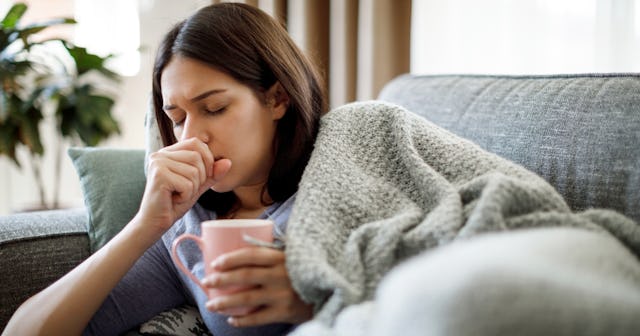Yes, You Can Get Mono Without Kissing! What To Know (And How To Avoid It)

Anyone who came down with a case of mono in high school can likely attest to the teasing that often comes along with catching the so-called kissing disease. Because of its nickname, people often mistakenly believe the only way to get mono is through kissing someone, but that’s definitely a misnomer in the health world. So, how do you get mono? Well, locking lips with an infected person is one way to catch a case of infectious mononucleosis, but it’s certainly not the only way the disease is transmitted.
In actuality, mononucleosis is caused by an infection with the Epstein-Barr virus (EBV). While other viruses can sometimes cause the disease, EBV is the most common culprit, and according to the CDC, children as young as one can catch EBV. In fact, many children catch the virus and experience zero symptoms. And the good news is if you or your teen caught EBV as a child, you are highly unlikely to develop a second case of mono — even if you didn’t experience symptoms when you were initially infected.
However, if you didn’t catch EBV in your early years, then chances are you may develop a case of mono later in life. While the most affected age groups tend to be teens and college students, you can catch mono at any age. So, even if you managed to make it into adulthood without coming down with a case of the dreaded kissing disease, that doesn’t mean you have some sort of natural immunity. It most likely just means you’re very careful about sharing drinks and utensils with friends.
Here’s everything you need to know about how mono passes from one person to another — and what you should and shouldn’t do if it makes its way to you.
How do you actually get mono?
While EBV and other viruses cause mono, the disease is spread primarily through saliva and other bodily fluids. As a result, you can catch mono if you share utensils or drinks with an infected person. And yes, if you kiss someone with mono, you are likely to catch the disease as well. Other ways mono spreads include sexual contact, blood transfusions, and organ transplants, and to a lesser extent, sneezing and coughing.
Parents and young adults alike should know that mono has a long incubation period, so a person can be infected up to a month before they begin experiencing symptoms. And even though they may feel fine, they’re already contagious — all the more reason to avoid sharing drinks, utensils, and other personal items with your friends (and to advise your kids to do the same).
What are the symptoms of mono?
If you become infected with mono, you can expect symptoms to develop within four to six weeks. The CDC also warns that symptoms don’t always occur all at once, so you may experience them gradually over two to six weeks (or longer, in some cases). If you or your child start experiencing any of the following symptoms, it’s time to call the doctor:
- Fever
- Sore throat
- Body aches/headache
- Fatigue
- ‘Mono rash’
- Swollen lymph nodes in armpits or the neck
Sometimes, mono can also lead to more severe symptoms, including swelling in the liver and spleen.
What are the stages of mono?
When dealing with mono, there are three stages of this viral infection to look out for:
- Stage 1 Prodrome. This stage lasts for three to five days and is when infected people show fatigue or sometimes no symptoms at all.
- Stage 2 Acute Phase. Symptoms in this phase are a bit more intense and include fever, swollen lymph nodes, sore throats, headaches, or rash.
- Stage 3 Convalescent Phase. During this stage, most symptoms have disappeared, but you still may feel a bit of fatigue.
How long does mono last?
Once you catch EBV, it remains in your system for the rest of your life. That’s because EBV is a member of the herpes virus family. Luckily, it rarely reactivates after the initial infection, although you may become contagious again if it does.
In terms of a case of mono, it’s unclear how long a person remains contagious, but symptoms of mono generally only last for four to six weeks. But in some cases, symptoms can linger for as long as six months, with fatigue being a particularly persistent issue for some patients. If you or your child is dealing with a case of mono, it’s essential to drink plenty of fluids, rest up, and take over-the-counter pain relievers to help with any fever or aches and pains.
One thing you should never do if you have mono is take penicillin-based antibiotics. The CDC also recommends avoiding participating in contact sports until your doctor gives you the OK, due to the possibility of a spleen rupture.
Even though mono comes with a bit of a stigma due to its old-fashioned nickname, it’s a common disease that many people catch during their younger years (and sometimes later in life, too). Although it’s certainly no fun to deal with, mono usually resolves itself within one to two months. If you want to help your child avoid a case altogether, the best thing you can possibly do is stress the importance of not sharing personal items between friends. It’s not a foolproof method of avoiding mono, but it’s still your best line of defense.
Can you get mono twice in your lifetime?
It’s possible to get mono more than once. Usually, after a person contracts the Epstein-Barr virus, they may develop an immunity, even though the virus remains in the body for the rest of their life. If someone experiences mono twice, it’s usually triggered by other medical issues or infections.
This article was originally published on